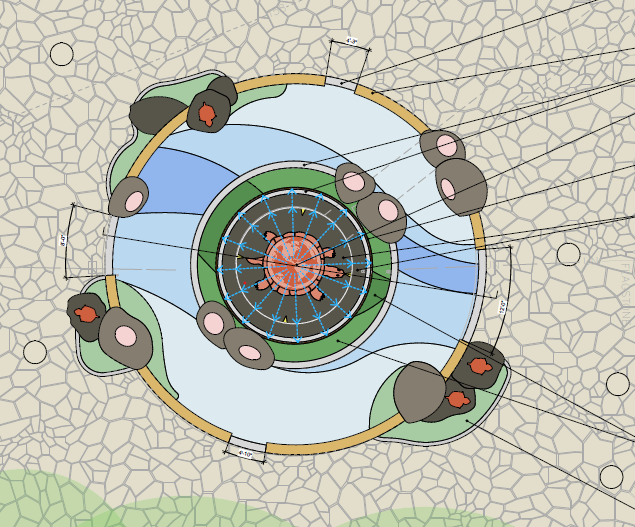
- Details
- By Nanette Deetz
BERKELEY, Calif. — More than 30 years ago, Potawatomi artist Lee Sprague had a dream that integrated his people’s traditional creation story of how Mother Earth was conceived on a single giant turtle’s back.
He woke up and drew the dream on paper, imagining it as a monument to Indigenous peoples.
The sketch was refined and presented to the Berkeley City Council in 1992 by Sprague and Navajo designer Marlene Watson in hopes of erecting a sculpture called “Turtle Island Monument” in Martin Luther King Jr. Civic Center Park, located opposite of Berkeley City Hall. The intent was to replace a colonial-era fountain built in 1947.
Sprague was no stranger to advocating for change on behalf of Native Americans. An employee at the University of California, Berkeley, during the early 1990s, Sprague was active in the Resistance 500, the group that convinced the Berkeley City Council in 1992 to declare Oct. 12 as Indigenous People’s Day, making it the first city in the United States to do so. At the same time, the city council approved the Resistance 500 task force to work with and honor Indigenous tribal nations and agreed to erect a monument in the Martin Luther King, Jr. Civic Center Central Park.
Sprague’s monument design depicted a large turtle standing with a softly cascading water feature with openings to the four directions. The water feature represented the importance of water to all life and would water plants in the park. The proposal was rejected.
Sprague, who now lives in Michigan, flew to California last month — decades after he first presented the idea to the Berkely City Council — to again propose erecting the Turtle Island Monument in the park. The vote was a resounding 6 to 1 victory in favor as the City of Berkeley Landmark Preservation Commission approved a Structural Alteration Permit (SAP) for the monument.
The Turtle Island Monument is estimated to be completed by the end of 2024 and will be dedicated to the Indigenous Tribal Nations on this continent. A time capsule will be buried beneath the central structure.
“I am pleased with the Landmark Preservation Commission’s vote to approve the next step in the decades-long journey. Beginning in 1992, the City of Berkeley took the time to gather and listen to indigenous peoples’ voices and proclaimed this hemisphere’s first Indigenous Peoples’ Day and the Turtle Island Monument,” Sprague told Native News Online. “The current Berkeley city officials have reconnected, sought out and listened to indigenous voices, to the Commissioner’s and citizen’s voices to renew the Turtle Island Monument and the 500th year commemoration of finding Columbus on indigenous shores.”
When presenting her support for the Turtle Island Monument, designer Marlene Watson — a member of the American Indian Science and Engineering Society — said: “I want our Native youth to be inspired, to know that they can make a difference in their community. I want them to walk by it and say, ‘that’s me, that’s my people represented there. I am someone who matters. I don’t have to be invisible anymore. I can do that too someday.’ It’s been an honor to work with this project every step of the way.”
Berkeley’s Chief Cultural Affairs officer Jennifer Lovvorn was also pleased with the Landmark Preservation Commission’s approval.
“Lee and Marlene were effective in their advocacy and convinced the City Council to move forward with their original design,” Lovvorn said. “Everyone on the team wants to see this project completed.”
Numerous citizens of Berkeley wrote letters to the Commission, and those who attended spoke in support. Many members of the local Native American community offered strong, heartfelt words of support for the Turtle Island Monument. Theda New Breast (Blackfoot) —one of the first Native American students to attend UC Berkeley — spoke and introduced the Red Lightening Women Power singers who sang the Strong Woman song.
Many members of the Indigenous Peoples’ Day Committee also spoke in support of the Turtle Island Monument.
Joaquin Cruz (Comanche/Yaqui), a member of the Indigenous Peoples’ Day committee, read a letter of support written by John Curl, an original member of the 500-year Resistance Task Force and Indigenous Peoples’ Day committee.
Curl’s letter read, “At the heart of the city, the Turtle Island Monument will represent the very best that Berkeley has to offer the world. Sustainable and constructive lifeways in harmony with the environment that Indigenous people have always tried to live by; the values that we all need to survive and thrive.”
Nanette Deetz is a Lakota, Dakota, and Cherokee poet and writer who holds a B.A. and M.A. from UCLA. She is a published poet whose poetry appears in numerous anthologies, most recently in “Red Indian Road West: Native American Poetry from California,” published by Scarlet Tanager Books, Oakland, California.
Help us defend tribal sovereignty.
At Native News Online, our mission is rooted in telling the stories that strengthen sovereignty and uplift Indigenous voices — not just at year’s end, but every single day.
Because of your generosity last year, we were able to keep our reporters on the ground in tribal communities, at national gatherings and in the halls of Congress — covering the issues that matter most to Indian Country: sovereignty, culture, education, health and economic opportunity.
That support sustained us through a tough year in 2025. Now, as we look to the year ahead, we need your help right now to ensure warrior journalism remains strong — reporting that defends tribal sovereignty, amplifies Native truth, and holds power accountable.
 The stakes couldn't be higher. Your support keeps Native voices heard, Native stories told and Native sovereignty defended.
The stakes couldn't be higher. Your support keeps Native voices heard, Native stories told and Native sovereignty defended.
Stand with Warrior Journalism today.
Levi Rickert (Potawatomi), Editor & Publisher

